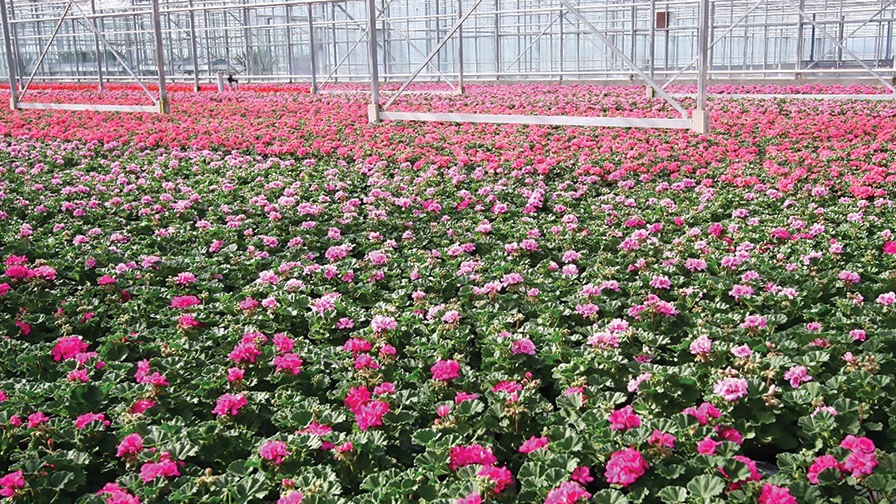How Plant Growth Regulator Suppliers Are Continuing to Make Improvements

Geraniums showing consistent growth due to plant growth regulator applications. Photo by Fine Americas.
Research is ongoing in the world of plant growth regulators (PGRs). As new developments, methods, and products continue to hit the market, an update is in order to see what researchers and companies have in the works to help you control crop height and improve crop quality.
SePro is Working to Enhance Use Rates and Timing
SePRO, a research-based life sciences company, is currently working on enhancing use rates and timing for TopFlor L, an ornamental PGR. This product is active on a wide range of crops and has improved plant uptake with high activity through plant roots. SePRO has found through its research that this product can be a tool for reducing the need for trimming and extending the length of regulation attained with a PGR application. For best overall results, SePRO suggests starting a PGR program early to help plants get off to a strong start and maintain more uniformity throughout production.
Fine Americas is Educating Growers
Fine Americas is a center for PGR technology and innovation.
“We’re finding new ways to bring the research results to growers, like partnering with industry experts and university researchers to produce annual and perennial PGR guides and training webinars, as well as monthly blogs that keep growers updated on the latest research results,” says Jim Scruggs, Manager of Technical Services for Fine Americas.
Fine Americas formulated the newest addition to its product line, Piccolo 10XC, to overcome the problems that result from an active ingredient settling out of solutions in containers and spray tanks during applications. The company says this new formulation provides a stable spray solution, resulting in consistent outcomes in the greenhouse.
OHP Helps Growers Maximize PGR Use
Dave Barcel, Senior Technical Manager at OHP, says that while the use of PGRs and products is important, the possibility of changing the environment with greenhouse lighting could provide the grower with advantages for producing a more desired product.
OHP manufactures PGR products, including B-Nine and Paczol. Nearly a year ago, OHP redesigned its Plant Growth Regulator Calculator app, a valuable in-field tool for PGR rate calculations that helps growers optimize PGR use.
“These are exciting times for growers as they find ways to produce high-quality crops with fewer resources or different inputs,” Barcel says.
Regulate Plant Growth With an Alternative Method
Oxygen Research Group, dedicated to increasing water oxygen by supplementation, has partnered with the University of Minnesota and the University of Tennessee to perform controlled testing to determine if raising Dissolved Oxygen (DO) levels over 10 ppm in water could have significant benefits to crops. Using science, the group can increase DO by up to 50% over traditional methods such as bubblers and venturis (aerators for adding DO). After two years, testing resulted in an average increase of 20% in plant growth, protection from root disease, and improved nutrient uptake through roots. This type of technology adds another tool growers can use within their PGR programs to help achieve the specific results they are looking for in their operations.
There are several applications for PGRs in the industry and many available product options for growers to choose from.
“PGR use is very personal in that, as much as it is a science, it is an art,” Barcel says.
Product labels and technical information provide a good starting point, but because every operation is different, each program will vary. A grower’s overall objectives will determine the best PGRs for the operation to use.
As Mark Brotherton, SePro’s T&O Product Manager, summarizes, “Each of the PGRs available has its own place in the toolbox.”
LumiGrow Tracks Effects of LED Lights on PGR Applications
LumiGrow, a company dedicated to offering smart horticultural lighting solutions, closely tracks plant morphology, development, and PGR applications throughout its LED trials. With proper lighting strategies, PGR effects can be increased and application frequencies could possibly be reduced. According to the company, blue light can create a more compact plant through reducing internodal spacing, and red light can stretch a plant or promote flowering. Currently, LumiGrow has multiple commercial trials in progress to study how light spectrum can drive plant morphology to the desired outcome.










